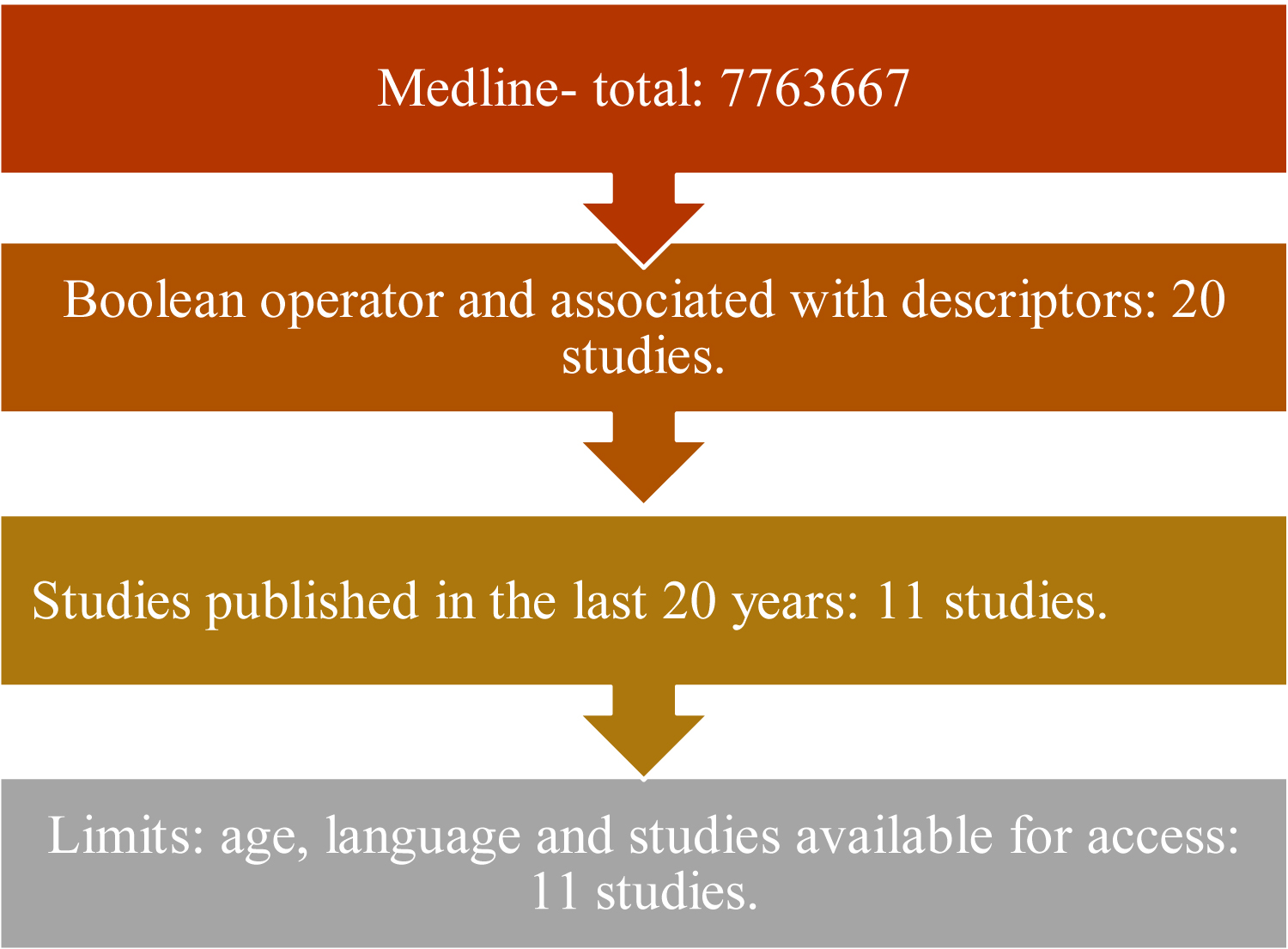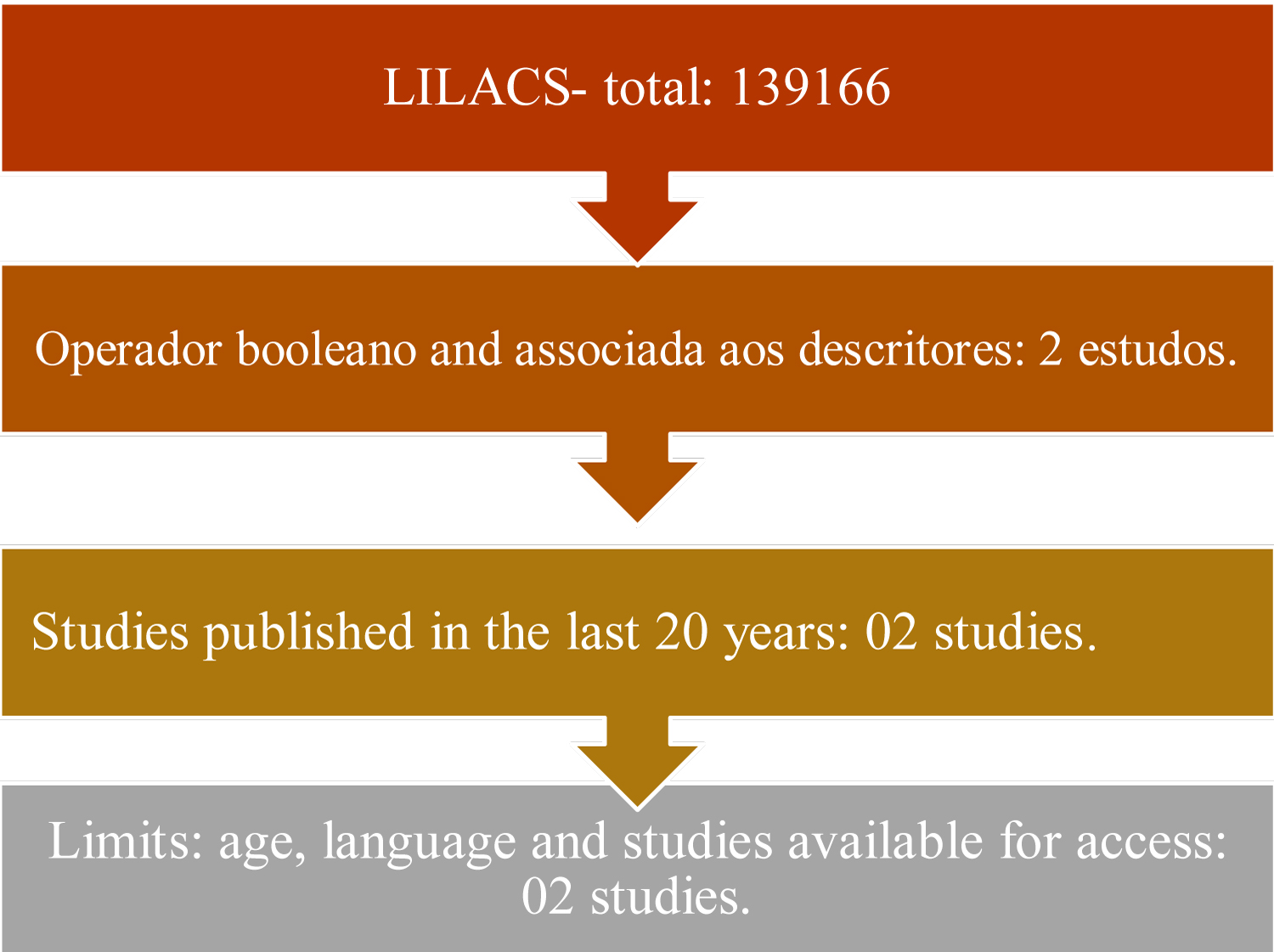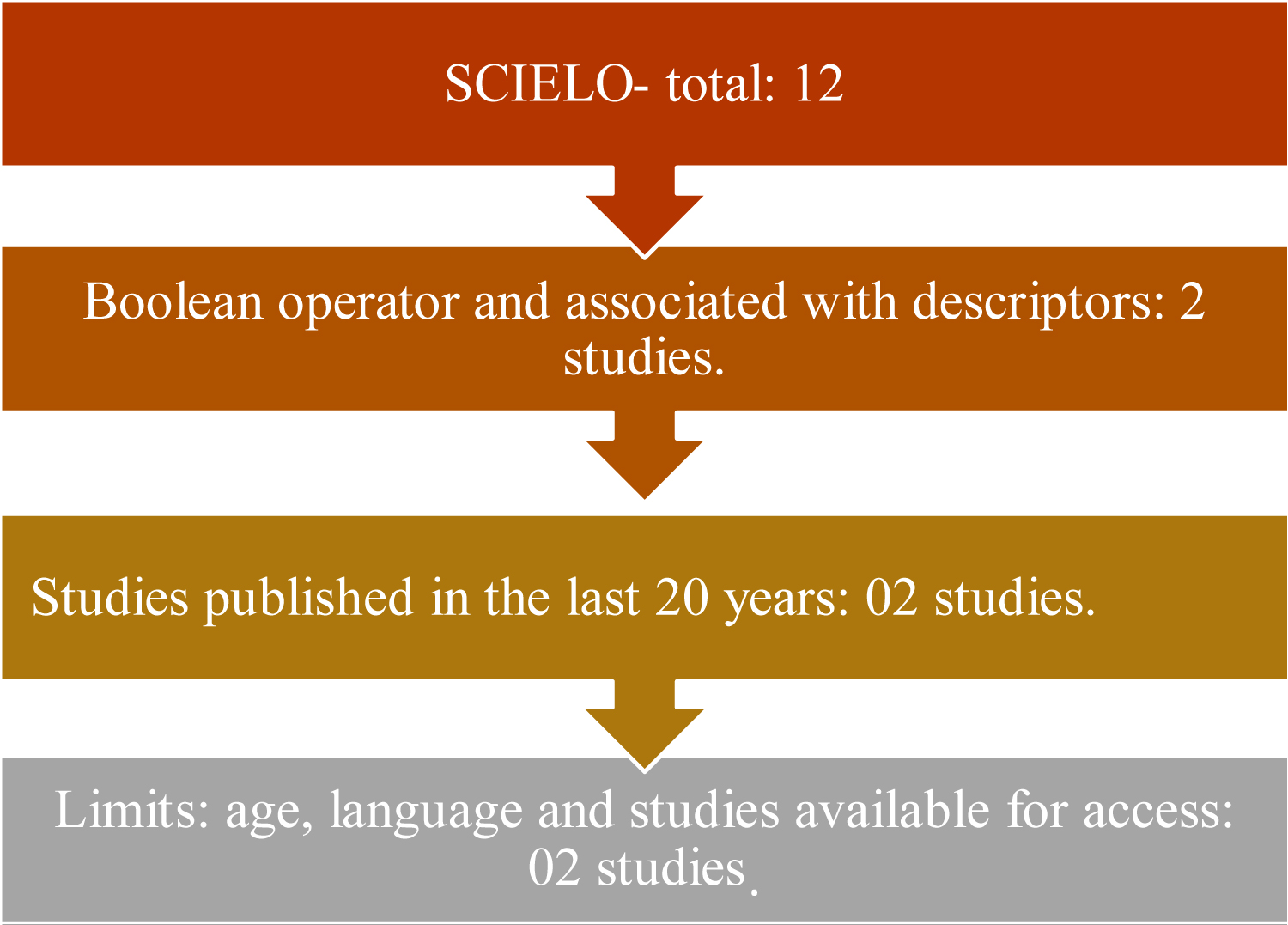Sickle cell disease is a broad term that defines a group of inherited diseases characterized by mutations in the gene that encodes the beta subunit of hemoglobin is a lifelong disease characterized by chronic hemolytic anemia, unpredictable episodes of pain and widespread damage of the organs [1,2]. The prevalence of osteonecrosis in patients with sickle cell disease is high, reaching about 50% of individuals, with the highest incidence of complications occurring in adolescence. To investigate the prevalence of femoral head ostenecrosis in pediatric patients with sickle cell anemia and to evaluate the associated risk factors.
An electronic search for studies developed in the last 20 years in the main databases was carried out: PUBMED, SCIELO, MEDLINE and BIREME using the descriptors: Femoral head osteonecrosis, sickle cell anemia, prevalence associated with Boolean operators: or and and. Studies published in English, pediatric age range between 0 and 18 years and studies available for access, were adopted as limits. At the end, 28 scientific articles were found. After reading the title and summary, only one study fit for the present bibliographic review was selected, the only study carried out to date on this topic.
The present literature review found only one study that carried out with pediatric patients relating sickle cell anemia and osteonecrosis of the femoral head. This study showed that the prevalence of osteonecrosis of the femoral head in the pediatric age group is 39.4% and is associated with a longer time since the disease was diagnosed (97 months), previous trauma in 92% of cases, and an average score of Charnley 15 points. This was the only study carried out to date that evaluated hip dysfunction and osteonecrosis of the femoral head, and it is urgent and essential to carry out further studies on this subject, given the rapid progression of femoral osteonecrosis. Early diagnosis and thus treatment would guarantee less physical and social suffering for the child.
Thus, from the present bibliographic review, it is concluded that there is an urgent need for further studies that relate the prevalence of osteonecrosis of the femoral head and hip dysfunction in pediatric patients with sickle cell anemia, with a lack of the number of studies carried out in children.
Osteonecrosis, Child health, Sickle cell, Femur head
Sickle hemoglobinopathies comprise a variety of diseases that are characterized by the presence of hemoglobin S (HbS). Sickle cell disease is inherited as an autosomal coding trait in individuals who are heterozygous for the β Sallele, such as who carry along with the HbS the HbA or HbC, known as sickle cell trait (HbAS), or hemoglobin SC disease HbSC while individuals who are homozygous for the β S allele (HbSS) have SCA. SCA is the most common form of SCD. Sickle cell disease is a lifelong disease characterized by chronic hemolytic anemia, unpredictable episodes of pain and widespread organ damage [1,2].
Among the Afro-descendants of the new world, the heterozygous genotype reaches 10% in the USA, more than 6% in the S-SE of Brazil, and up to 15.7% in the State of Bahia [1]. In the case of HbS, the highest prevalence occurs in tropical Africa and among blacks from countries that participated in the slave trade [3]. In Brazil, about 0.1% to 0.3% of the black population is affected by the disease [4] and it is estimated that there are at least two million HbS carriers (heterozygotes). In the Southeast region, the estimated prevalence of heterozygotes is 2% in the general population and, among blacks, 6% to 10% [5]. In a population-based study [6] in Minas Gerais, the incidence of one new homozygous case was reported for every 2,800 births for sickle cell disease. In the State of Lobo, et al. [7] reported the incidence of a new case of this disease for every 1,196 births.
When analyzing sickle cell anemia in relation to childhood, it is observed that there is a high morbidity and mortality due to, among other factors, the crises of bone infarction, bacterial sepsis, splenic sequestration and also the acute chest syndrome in addition to the deleterious effects of anemia on the physiological development and intellectual of the individual [1,8]. In fact, the prevalence of osteonecrosis (ON) in patients with sickle cell disease is high, reaching about 50% of individuals, with the highest incidence of complications occurring in adolescence [9,10]. The involvement of osteonecrosis of both hips is seen in about 40-91% of patients with ON. As demonstrated by HERNIGOU, et al. [11], progression to femoral head collapse in sickle cell patients occurs in 90% of cases within two years after the initial diagnosis of stage I osteonecrosis. In addition, the inefficiency and failure of total arthroplasties in these patients are particularly high, with pain incidence and substantial movement limitations in 75% of sickle cell patients [12,13]. These studies suggest that the clinical progression of femoral osteonecrosis in patients with sickle cell disease is more frequent and faster than has been described for other pathologies with non-traumatic osteonecrosis.
Given the above, the present study aims to investigate the prevalence of femoral head ostenecrosis in pediatric patients with sickle cell anemia and to assess the associated risk factors. For that, an electronic search of studies developed in the last 20 years in the main databases was carried out: PUBMED, SCIELO, MEDLINE AND BIREME using the descriptors: Femoral head osteonecrosis, sickle cell anemia, prevalence associated with Boolean operators: or and and. Studies published in English, pediatric age range between 0 and 18 years and studies available for access, were adopted as limits. At the end, 28 scientific articles were selected for the present bibliographic review.
An electronic search was performed in the databases: PUBMED, SCIELO, MEDLINE, BIREME on 12/13/19. The following descriptors were used: Femoral head osteonecrosis, sickle cell anemia, prevalence associated with the following Boolean operators: or and and. Initially, when using the Boolean operator or 10684675 articles were found.
For a better selection of articles to be included in this review, the following limits were adopted: 1) Articles in English published in the last 20 years. 2) Pediatric age group - patients between 0 and 18-years-old.
For a better delimitation of these for the present review, the Boolean perador was associated, and at the end, 64 eligible articles were found in the 4 databases. After defining these limits, 28 articles were selected. Below is the flowchart specified for each database with that selection.
Database: PUBMED
Search on: Femoral head osteonecrosis or sickle cell anemia or prevalence.
Total of references: 2781830 studies.
Search on: Femoral head osteonecrosis and sickle cell anemia and prevalence.
Total of references: 40 studies.
Studies published in the last 20 years: 31 studies.
Studies performed on patients from birth to children under 18: 18 studies.
Studies published in English and Portuguese: 14 studies.
Studies available for access: 13 studies (Figure 1).
 Figure 1: Flowchart - Selection of studies - PUBMED database.
View Figure 1
Figure 1: Flowchart - Selection of studies - PUBMED database.
View Figure 1
Database: MEDLINE
Search on: Femoral head osteonecrosis or sickle cell anemia or prevalence.
Total of references: 7763667
Search on: Femoral head osteonecrosis and sickle cell anemia and prevalence.
Total of references: 20 studies.
Studies published in the last 20 years: 11 studies.
Studies carried out in patients from birth to children under 18: 11 studies.
Studies published in English and Portuguese: 11 studies.
Studies available for access: 11 studies.
As this data base does not have a filter for the age of the participants, the abstracts of each article were read in order to establish the age range from 0 to 18 years, with 11 studies selected for the present review being selected (Figure 2).
 Figure 2: Flowchart - Selection of studies - MEDLINE database.
View Figure 2
Figure 2: Flowchart - Selection of studies - MEDLINE database.
View Figure 2
Database: LILACS
Search on: Femoral head osteonecrosis or sickle cell anemia or prevalence.
Total of references: 139166.
Search on: Femoral head osteonecrosis and sickle cell anemia and prevalence.
Total of references: 2 studies.
Studies published in the last 20 years: 2 studies.
Studies performed on patients from birth to children under 18: 2 studies.
Studies published in English and Portuguese: 2 studies.
Studies available for access: 2 studies (Figure 3).
 Figure 3: Flowchart - Selection of studies - LILACS database.
View Figure 3
Figure 3: Flowchart - Selection of studies - LILACS database.
View Figure 3
Database: SCIELO
Search on: Femoral head osteonecrosis or sickle cell anemia or prevalence.
Total of references: 12.
Search on: femoral head osteonecrosis and sickle cell anemia and prevalence.
Total of references: 2 studies.
Studies published in the last 20 years: 2 studies.
Studies performed on patients from birth to children under 18: 2 studies.
Studies published in English and Portuguese: 2 studies.
Studies available for access: 2 studies (Figure 4).
 Figure 4: Flowchart - Selection of studies - SCIELO database.
View Figure 4
Figure 4: Flowchart - Selection of studies - SCIELO database.
View Figure 4
After making the selection of the articles found, the title and abstract were read and the duplicate articles were removed and thus identifying those suitable for the present review. At the end of the selection, only one article was found that showed the prevalence of osteonecrosis of the femoral head in patients diagnosed with sickle cell anemia with hip dysfunction in the pediatric age group, the other studies being excluded.
Avascular necrosis of the hip is a common cause of morbidity in sickle cell disease (SCD). Its prevalence increases with age and pre-disposing factors include a co-existing trait of thalassemia, frequent vaso-occlusive crises, and high hematocrit (Hct) [14]. Seeking to investigate the prevalence of hip fracture in patients with sickle cell anemia in the pediatric age group and after reading the title and summary, only one study was found that analyzed the prevalence of osteonecrosis of the femoral head in patients with sickle cell anemia with hip dysfunction in that range age. A study by Almeida Matos, et al. [15] aimed to verify the prevalence of avascular necrosis of the femoral head in pediatric patients diagnosed with sickle cell anemia, as well as the associated risk factors. For this, across-sectional study was conducted with a group of 92 individuals who had sickle cell disease. Of this total, about 43 individuals had hip dysfunction, and 13 of them were diagnosed with avascular necrosis of the femoral head. Therefore, the overall prevalence of hip fractures in such a study was 39.4% among patients with hip dysfunction. When comparing with the control group formed by 20 patients, there were no significant differences in demographic variables, however, when comparing the clinical characteristics between the two groups (AVN and control), they showed significant differences in the time of diagnosis of sickle cell disease, previous history of trauma in the hip, presence of pain in the hip and in the mean values of the functional scores, both for right and left hip. When analyzing laboratory tests in the control group, there were higher percentage rates of fetal hemoglobin, platelets and lower rates of total hemoglobin. Possibly, high levels of HbF act as protection, especially against comorbidities related to vessel occlusion and increased viscosity.
This study concludes that pediatric patients with sickle cell anemia and hip dysfunction have a prevalence of 39.4% of osteonecrosis of the femoral head, which is associated with a longer time of diagnosis of the disease (97 months), previous trauma in 92% of the patients. Cases, and an average Charnley score of 15 points. This study concludes that the early evaluation of the hip of children with sickle cell disease, and also the search for risk factors associated with osteonecrosis, can result in greater prevention, early treatment and possible reduction of the sequelae that increase the physical and social suffering of these children. Or the consequences that directly decrease the quality of life of people with sickle cell anemia [15]. It is important to highlight that this is the first study carried out in the scientific literature on the association between clinical hip dysfunction and osteonecrosis of the femoral head in children.
Through the present bibliographic review, it is concluded that there is an urgent need for further studies that relate the prevalence of osteonecrosis of the femoral head and hip dysfunction in pediatric patients with sickle cell anemia, with a lack of the number of studies carried out in children. The present review found only one study, the first ever carried out in the scientific literature on the association between clinical hip dysfunction and osteonecrosis of the femoral head. It is important to note that early treatment is essential to prevent osteonecrosis of the femoral head in patients with hip dysfunction, and that early diagnosis would guarantee adequate treatment and thus a better quality of life, reducing the physical and social suffering of these children. Thus, it is essential to carry out new studies relating this theme in the pediatric age group.
The authors participated in the elaboration of the research, selection of the studies, organization of the content, design of the study as well as in the writing of the content of this systematic review. They also approved the final version to be published and are responsible for all aspects of the work, including ensuring its accuracy and integrity. They also declare that the authors contributed equally.